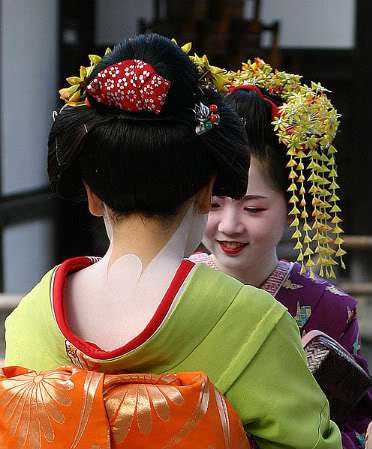
Apprentice geisha by Daniel Bachler.
Konnichiwa! Ogenki desu ka? (Hello, How are you?)
*bowing*
Are you ready to travel to the Land of the Rising Sun? We’ve no better guide than the lovely and talented Debbi Michiko Florence, who just published her second Kaleidoscope Kids activity book, Japan (Williamson Books, 2009)!

Nonfiction activity book for ages 7-14, 95 pages.
This irresistible, 95-page mega-feast is overflowing with delectable facts and interactive activities for kids ages 7-14, touching on bits of history, geography, sports, wildlife, language, music, philosophy, religion, cultural celebrations and more.
If you sat down and made a list of everything that comes to mind when you think of Japan, chances are good Debbi has covered it: sumo wrestling, bonsai, cherry blossoms, kimonos, samurai, ikebana, origami, haiku, Mt. Fuji, snow monkeys, puppet shows, tea ceremonies.

Chaya (teahouse) in Nara by Michael Maggs.

photo by antonioperezrio.es
*deep breath*
Okay, let’s just take a moment to send Debbi at least one hundred extra hugs for my favorite section in the book, “Food Mysteries.”
*drools*

photo by KaiChanVong.
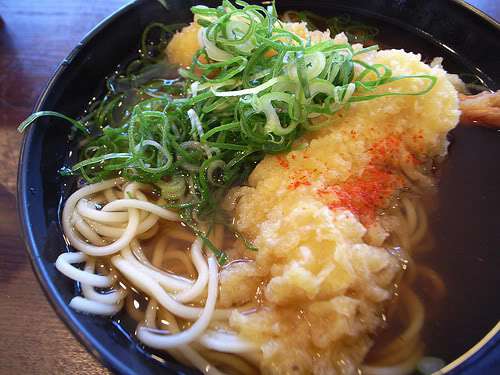
Soba by nobrinskii.
There is mention of mochi, sushi, tofu, soy sauce, miso, omusubi, wasabi, nori, soba, ramen, sashimi, bento and tempura! Need a chopstick lesson or quick recipe for microwave mochi? Want to make a special sauce to dip your soba noodles in? It’s all here, along with a primer on table manners. Throughout the book, there are pronunciation guides for all the Japanese words, illustrated diagrams for the activities, little sidebar infobits just to keep everything interesting, some photos, and lots of humorous spot illos by Jim Caputo, who also worked on Debbi’s first book about China.
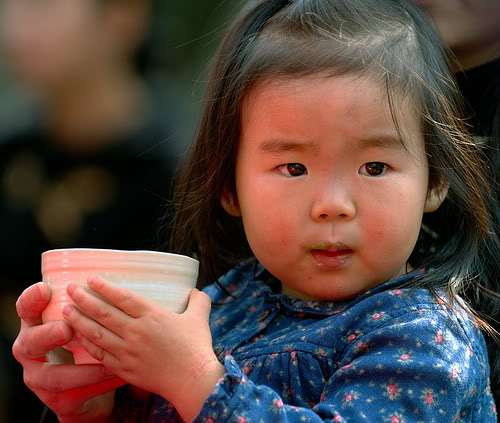
“My first tea ceremony” by puddleduckz.
My second favorite section after the food chapter is the one explaining Japan’s three writing systems — hiragana, katakana, and kanji. Kanji uses ideograms, while hiragana and katakana are unique alphabets♥, one for writing original Japanese words, and the other for foreign or “loan” words. Debbi has included tables for each of the alphabets so kids can practice writing. Also fun are the mini lessons on how to count in Japanese and say some common phrases and words. Hai! Once they’re done with these, readers can decide whether they’d like to make a daruma (good luck charm), carp banner, miniature Japanese garden, or origami goldfish. And then they can hear from some Japanese students their own age!

“To school” by SBA73.
The section entitled, “Kids Will be Kids” features some great insight about everyday life in Japan. We learn about the importance of school entrance exams, juku (cram school), and how much time is devoted to homework. Twenty-nine students from Yanai-City, Yamaguchi Prefecture, ages 7-12, responded to such questions as, “What is your favorite subject in school?” and “What do you like to do in your free time?” A nice personal touch to an already engaging chapter.

Dolls for Girls’ Day (March 3) by St Stev.
Japan is both fun and challenging, and will no doubt invite readers back again and again, long after that last bite of sushi has been eaten. It’s great for independent or group activity, and is highly recommended for school and home libraries.
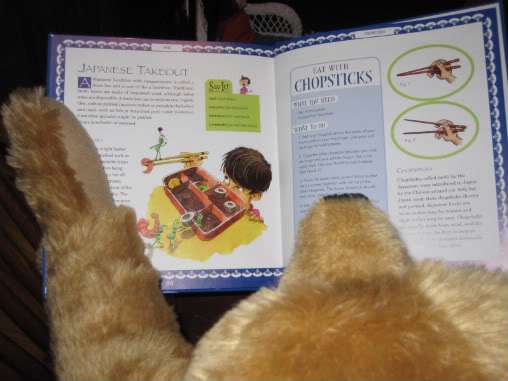
Please join me now in congratulating Debbi for all her hard work in creating this awesome book. In the “Holidays and Festivals” section, it says, “for almost all celebrations, including New Year’s Day and birthdays, the Japanese say “omedeto,” which means “congratulations.”
All together now: Omedeto, Debbi, and Arigato!
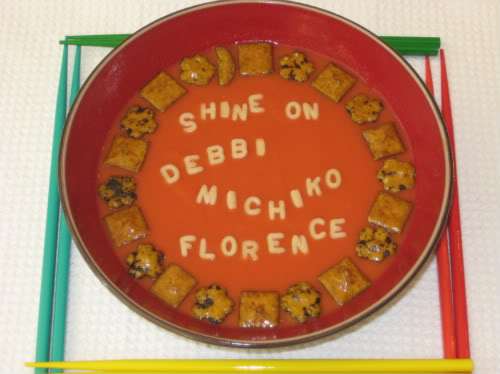
Today’s Special: Rising Sun Soup with Rice Crackers (oishii !)
In Japan, it’s good manners to slurp! All done? Help yourself to some wagashi, special confectionaries served at tea ceremonies. Traditional wagashi is usually made from mochi, azuki bean paste, and seasonal fruits, and was a popular gift between samurai. Serving good wagashi shows one’s educational background.☺

photo by moriza.
Don’t forget to check your local indie or order your copy of Japan online.

Sayonara!
♥ ♥ ♥ ♥ ♥ ♥ ♥
For more about Debbi and her books, visit her official website and Live Journal blog, One Writer’s Journey.
♥ Today’s Nonfiction Monday Roundup is at Anastasia Suen’s Picture Book of the Day.
♥ This post is also being submitted to the Color Me Brown challenge over at Color Online. One week left to submit your reviews of books by and about POC!
*Note: photos in this post are not from the book.
Copyright © 2009 Jama Rattigan of jama rattigan’s alphabet soup. All rights reserved.

Bravo, Jama! You did it again. I love the way you celebrate books…….
Omedeto, Debbi!!!!! 🙂
LikeLike
What a BEAUTIFUL write-up. Yay Debbi!!!!! 🙂
LikeLike
Yay! Go, DMF!
LikeLike
Thanks, Tammi. Japan is one delicious book :)!
LikeLike
Thanks, Jo. 🙂
LikeLike
I second and third that!
LikeLike
Beayoooooootiful post! The book sounds great. Must find it for my girls!
Jules
7-Imp
LikeLike
Tanita Says :
Kawaii overload!
I hate so much to deconstruct an entire culture down to “SO CUTE!” but even Japanese food holds an appeal for me, colorful and toothsome and so meticulously prepared. And that’s what this book has in common — colorful and toothsome and meticulously shared — opening up a tasty sample of an ancient and complex culture to our eager eyes. Beautiful, and as always, a beautiful post as well.
LikeLike
There are so many fun activities to try. They’ll definitely enjoy it :).
LikeLike
Re: Tanita Says :
Yes, the Japanese take great pride in the beauty of their plating. Love how eating is a “total” experience. Of course, I will say that as Japanese food is my favorite :)!
LikeLike
What a FANTASTIC-looking book! Thanks for sharing all the goodies. I just wish there was something just like this for China.
LikeLike
There is! Debbi’s first book is just like this (same series), only about China. Click on my link in the post!
LikeLike
Oooh, thank you for pointing out what I’d missed. I’ve put it on my Amazon wishlist so I don’t forget it, and it will likely be under the tree for my seven-year-old (who is the one most focused on her ethnic heritage) this Christmas. 😀 I confess, though, that I’m still half-tempted by the Japan book – seeing as it’s the author’s own heritage, I’m sure it’s even more chock-full of goodies.
LikeLike
They make a nice pair :). Both would love to be under the tree at Christmas. Debbi lived in China for awhile so her first book is fabulous too (recipe for dumplings). These are great introductory books to the countries — there are interesting facts, and the activities engage kids directly, which is fun.
LikeLike
This looks like a lovely book. I have some little Japanese dolls, a kimono, and shoes from the penpal I had years ago when I was in high school. I also have chopsticks and a lovely silk scarf from an exchange student my son and his wife hosted a few years back. She was from Okinawa. Must check into this book. Thanks.
LikeLike
What lovely keepsakes! Is your doll wooden? There’s a section on Kokeshi dolls in this book :).
LikeLike
Yes, there are five of them, the mother and four children (I suppose) They’re handpainted. I wonder if they are the Kokeshi dolls. Will have to see.
LikeLike
good series
This sounds like not only a lovely book but also a lovely series. How many books in the series?
LikeLike
Re: good series
I think there are about 9 books in the series so far; other titles include Greece and Rome (not by Debbi).
Check the publisher’s page:
http://www.idealsbooks.com/index.asp?PageAction=VIEWCATS&Category=95.
LikeLike